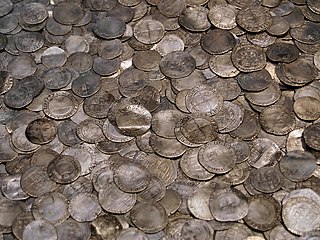
A hoard or "wealth deposit" is an archaeological term for a collection of valuable objects or artifacts, sometimes purposely buried in the ground, in which case it is sometimes also known as a cache. This would usually be with the intention of later recovery by the hoarder; hoarders sometimes died or were unable to return for other reasons before retrieving the hoard, and these surviving hoards might then be uncovered much later by metal detector hobbyists, members of the public, and archaeologists.
St Ninian's Isle is a small tied island connected by the largest tombolo in the UK to the south-western coast of the Mainland, Shetland, in Scotland. It is part of the civil parish of Dunrossness on the South Mainland. The tombolo, known locally as an ayre from the Old Norse for "gravel bank", is 500 metres long. During the summer the tombolo is above sea level and accessible to walkers. During winter, stronger wave action removes sand from the beach so that it is usually covered at high tide, and occasionally throughout the tidal cycle, until the sand is returned the following spring. Depending on the definition used, St. Ninian's is thus either an island, or a peninsula; it has an area of about 72 hectares.

The Cuerdale Hoard is a hoard of more than 8,600 items, including silver coins, English and Carolingian jewellery, hacksilver and ingots. It was discovered on 15 May 1840 on the southern bank of a bend of the River Ribble, in an area called Cuerdale near Preston, Lancashire, England. The Cuerdale Hoard is one of the largest Viking silver hoards ever found, four times larger than its nearest rival in Britain or Ireland, according to Richard Hall. In weight and number of pieces, it is second only to the Spillings Hoard found on Gotland, Sweden.
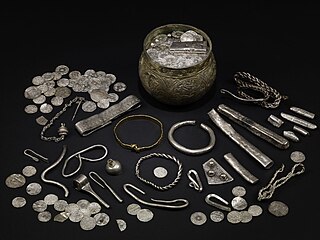
The Vale of York Hoard, also known as the Harrogate Hoard and the Vale of York Viking Hoard, is a 10th-century Viking hoard of 617 silver coins and 65 other items. It was found undisturbed in 2007 near the town of Harrogate in North Yorkshire, England. The hoard was the largest Viking one discovered in Britain since 1840, when the Cuerdale hoard was found in Lancashire, though the Anglo-Saxon Staffordshire Hoard, found in 2009, is larger.

The Staffordshire Hoard is the largest hoard of Anglo-Saxon gold and silver metalwork yet found. It consists of almost 4,600 items and metal fragments, amounting to a total of 5.1 kg (11 lb) of gold, 1.4 kg (3 lb) of silver and some 3,500 pieces of garnet cloisonné jewellery. It is described by the historian Cat Jarman as "possibly the finest collection of early medieval artefacts ever discovered".
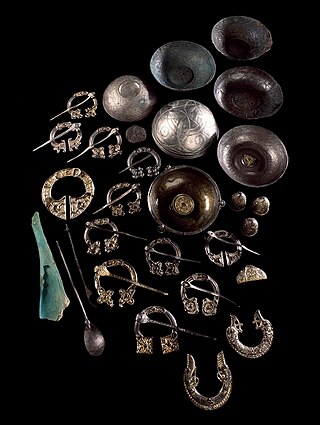
The St Ninian's Isle Treasure, found on St Ninian's Isle, Scotland in 1958 is the best example of surviving silver metalwork from the Early Medieval period in Scotland. The 28-piece hoard includes various silver metalwork items, including twelve pennanular brooches. The treasure is now in the National Museum of Scotland.

The Ormside Bowl is an Anglo-Saxon double-bowl in gilded silver and bronze, with glass, perhaps Northumbrian, dating from the mid-8th century which was found in 1823, possibly buried next to a Viking warrior in Great Ormside, Cumbria, though the circumstances of the find were not well recorded. If so, the bowl was probably looted from York by the warrior before being buried with him on his death. The bowl is one of the finest pieces of Anglo-Saxon silverwork found in England.
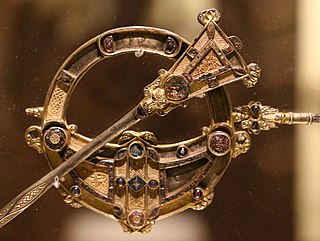
The Celtic brooch, more properly called the penannular brooch, and its closely related type, the pseudo-penannular brooch, are types of brooch clothes fasteners, often rather large; penannular means formed as an incomplete ring. They are especially associated with the beginning of the Early Medieval period in Ireland and Britain, although they are found in other times and places—for example, forming part of traditional female dress in areas in modern North Africa.
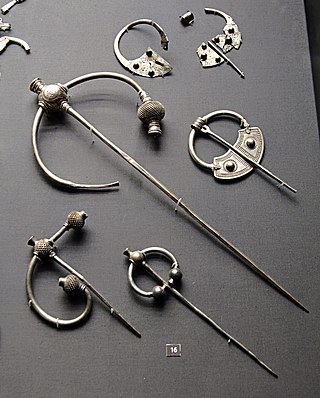
The Penrith Hoard is a dispersed hoard of 10th century silver penannular brooches found at Flusco Pike, Newbiggin Moor, near Penrith in Cumbria, and now in the British Museum in London. The largest "thistle brooch" was discovered in 1785 and another in 1830, with the bulk of items being recovered in two groups close to each other by archaeologists in 1989. Whether all the finds made close to each other were originally deposited at the same time remains uncertain, but it is thought likely that at least the brooches were. The brooches are thought to have been deposited in about 930.

The Silverdale Hoard is a collection of over 200 pieces of silver jewellery and coins discovered near Silverdale, Lancashire, England, in September 2011. The items were deposited together in and under a lead container buried about 16 inches (41 cm) underground which was found in a field by a metal detectorist. It is believed to date to around AD 900, a time of intense conflict between the Anglo-Saxons and the Danish settlers of northern England. The hoard is one of the largest Viking hoards ever discovered in the UK. It has been purchased by Lancashire Museums Service and has been displayed at Lancaster City Museum and the Museum of Lancashire in Preston. It is particularly significant for its inclusion of a coin stamped with the name of a previously unknown Viking ruler.
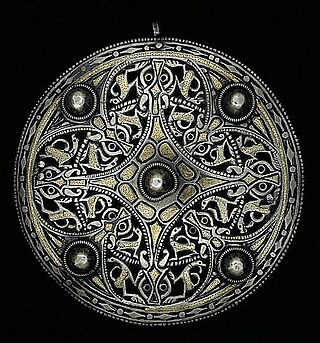
Trewhiddle style is a distinctive style in Anglo-Saxon art that takes its name from the Trewhiddle Hoard, discovered in Trewhiddle, Cornwall in 1770. Trewhiddle ornamentation includes the use of silver, niello inlay, and zoomorphic, plant and geometric designs, often interlaced and intricately carved into small panels. It was primarily used to decorate metalwork. During the late Anglo-Saxon era, silver was the precious metal most commonly used to create Trewhiddle style jewellery and to decorate weapons. Famous examples include the Pentney Hoard, the Abingdon sword, the Fuller brooch, and the Strickland brooch.

Norrie's Law hoard is a sixth century silver hoard discovered in 1819 at a small mound in Largo, Fife, Scotland. Found by an unknown person or persons, most of the hoard was illegally sold or given away, and has disappeared. Remaining items of the hoard were found later at the mound, and were turned over to the landowner, General Philip Durham. The surviving 170 pieces from the hoard are now in the National Museum of Scotland. The treasure consists mostly of hacksilver and includes four complete silver pieces. Both Roman and much rarer Pictish objects are among the survivals.

The Canterbury Treasure is an important late Roman silver hoard found in the city of Canterbury, Kent, south-east England, ancient Durovernum Cantiacorum, in 1962, and now in the Roman Museum, Canterbury, Kent. Copies of the main items are also kept in the British Museum.

The Bedale Hoard is a hoard of forty-eight silver and gold items dating from the late 9th to early 10th centuries AD and includes necklaces, arm-bands, a sword pommel, hacksilver and ingots. It was discovered on 22 May 2012 in a field near Bedale, North Yorkshire, by metal detectorists, and reported via the Portable Antiquities Scheme. Following a successful public funding campaign, the hoard was acquired by the Yorkshire Museum for £50,000.
The Lenborough Hoard is a hoard of more than 5,000 late Anglo-Saxon silver coins, dating to the eleventh century, that was found at Lenborough in Buckinghamshire, England in 2014. It is believed to be one of the largest hoards of Anglo-Saxon coins ever found in Britain. It is now on display at Discover Bucks Museum in Aylesbury.

The Pentney Hoard is an Anglo-Saxon jewellery hoard, discovered by a gravedigger in a Pentney, Norfolk churchyard in 1978. The treasure consists of six silver openwork disc brooches, five made entirely of silver and one composed of silver and copper alloy. The brooches are decorated in the 9th century Trewhiddle style. The hoard is now in the British Museum.
The Beeston Tor Hoard is an Anglo-Saxon jewellery and coin hoard discovered in 1924 at Beeston Tor in Staffordshire. The hoard consists of forty-nine coins, two silver brooches with Trewhiddle style decoration, three finger rings, and miscellaneous fragments. The coins date the burial of the hoard to approximately 875 AD.
The Herefordshire Hoard is a hoard of coins and jewellery dating to the Viking period found near Leominster, Herefordshire in June 2015.

The West Yorkshire Hoard is a precious-metal hoard of six gold objects, including four gold finger-rings, and a lead spindle whorl, which was discovered near Leeds, West Yorkshire, in 2008–2009 by a metal detectorist. The find was of national and international significance, expanding the understanding of hoards and hoarding in the north of England in early medieval England, as well as expanding the corpus of known gold rings from the period.

























